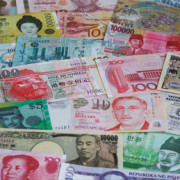Finance sector development
 Finance sector development
Finance sector development
 Miscellaneous
Miscellaneous
 Governance and public sector management
Governance and public sector management
 Finance sector development
Finance sector development
 Regional cooperation and integration
Regional cooperation and integration
 Education
Education
 Finance sector development
Finance sector development
 Social development and protection
Social development and protection
 Finance sector development
Finance sector development

US zero interest rates provoke world monetary instability and constrict the US economy

The international dollar standard is malfunctioning. The Fed’s reduction of the interest rate on Federal Funds to virtually zero in December 2008 (a move that was followed by major European central banks) exacerbated the wide interest rate differentials with emerging markets and provoked world monetary instability by inducing massive hot money outflows by carry traders into Asia and Latin America. The disruption could be partially justified if it had helped the United States recover from the 2008–2009 financial crisis. However, evidence suggests otherwise. Speculative money flooding into emerging markets by “carry traders” causes local currencies to be overvalued.
Should a resumption of US quantitative easing worry emerging Asia?

Two episodes of quantitative easing (QE) by the United States (US) Federal Reserve Bank (Fed) since early 2009 aroused widespread concerns in emerging Asia and elsewhere because of the possibility that they would weaken the US dollar (so-called “currency wars”) and stimulate capital inflows in emerging economies that might lead to increased inflationary pressures and asset price bubbles. For example, the vice minister of finance of the People’s Republic of China (PRC), Zhu Guangyao, said on 18 November 2010 that “As a major reserve currency issuer, for the US to launch a second round of quantitative easing at this time, we feel that it did not recognize its responsibility to stabilize global markets and did not think about the impact of excessive liquidity on emerging markets” (Reuters 2010).
Is the India growth story over?

Unexpectedly weak growth in the first quarter of 2012 was a slosh of icy water in the hot Indian summer. The near-halving of GDP growth to 5.3% in the first quarter of 2012 from a stellar 10.1% in the same period in 2010 has led some analysts to question whether India’s high-growth phase was a blip. However, a close look at the underlying causes of the present downturn suggests that it is cyclical, although with deep underlying distortions that need a fundamental overhaul to put growth back on track. The structural drivers capable of sustaining high growth rates over a long period remain in place.
Asia’s growth, production networks, and SMEs

The escalating Eurozone crisis and signs of spluttering world growth have put Asia and its manufacturing enterprises into the spotlight again. Part of Asia’s rapid trade-led growth over several decades is associated with production networks and a regional division of labor. An expanding literature suggests that the region’s trade is increasingly made up of growing intraregional trade in intermediate inputs (Athukorala 2011). Production activities are increasingly being geographically fragmented across countries and linked by a dense network of trade in intermediate goods (Baldwin 2008). Small- and medium-sized enterprises (SMEs) are viewed as the backbone of national economic development in many Asian economies, accounting for the majority of firms and a large share of employment (Harvie 2010).
Reforming the global financial architecture

The recent global financial crisis has renewed concerns about the inherent instability of the current international monetary system in which the world’s demands for asset or liquidity are met predominantly using the currency of one country, the United States dollar. If the supply of the global currency is inadequate to support global trade, the world faces deflationary risks. However, since the country issuing the global currency has the privilege of borrowing abroad in its own currency cheaply, its borrowing and, hence the supply of global currency, may become excessive. This may eventually become unsustainable, and may have significant systemic implications for the rest of the world, as witnessed in the global financial crisis.
It is time for binding agreements on migrants’ rights in Asia

Migration flows within Asia are of considerable size. According to the ILO (2006), between 1995 and 2000, 40% of the 2.6 million to 2.9 million Asian migrant workers (registered and undocumented) went to other countries in Asia, including the countries of the Gulf Cooperation Council (GCC) where Asian migrant workers made up 40% to 70% of the labor force in 2000. Unfortunately more recent data are not available, but the significance of intra-Asian migration constitutes a continuing trend. This post follows the definition of “Asia” used by the United Nations, which includes countries in the Middle East. The migration system in Asia is primarily based on temporary migration largely of low-skilled and semi-skilled workers, facilitated by private recruitment agencies (Wickramasekara 2006)
The PRC must invest in education for sustained development

Among the many challenges facing the People’s Republic of China (PRC) in the coming decades, the most important is its need to massively expand its investment in education. In an age of unprecedented levels of globalization, successful development has meant for the PRC, as for other countries, passing through three phases: Phase 1, joining the regional and global supply chains and production networks; Phase 2, imitating and adapting; Phase 3, innovating. These phases need not be mutually exclusive and may overlap.
Can internationalization of the renminbi succeed where internationalization of the yen failed?

Since the second half of the 1990s, Japan has tried to promote the use of the yen as an international currency but has made little progress so far. Now, following in Japan’s footsteps, the People’s Republic of China (PRC) is promoting the internationalization of the renminbi. It would do well to consider why Japan’s attempt at internationalizing the yen has failed. Until the Asian financial crisis in the second half of the 1990s, Japan was reluctant to promote the internationalization of the yen, fearing that capital flows could destabilize the economy and render monetary policy ineffective, a problem widely considered to be the major cost for a country promoting the international use of its currency.
Social enterprises can add a new twist to capitalism

The time has come to look at “social enterprises”—a form of capitalism that includes social and environmental objectives in addition to the profit motive. More than a century ago, Henry Ford asserted that “a business that makes nothing but money is a poor business.” The world is now overrun by such “poor businesses.” The heedless pursuit of financial gains may produce happy management teams and shareholders, but it also results in an unhappy planet for businesses to operate in. The solution is not for these businesses to give some money to charity, or to get employees to play “builder” or “teacher” for a day as part of so-called “corporate social responsibility” initiatives.
Fostering exchange rate coordination: the role of an Asian Currency Unit

Over the past few decades East Asia has become increasingly intertwined economically as the share of interregional trade in total trade has increased sharply across most economies, driven by regional supply chains and production networks. These production networks have also fostered greater investment links, with the production process being broken down into subprocesses within a particular industry. The high degree of economic integration indicates that there may be a case for exchange rate coordination, as exchange rate misalignments may result in loss of competitiveness for a country, possibly leading to an increase in protectionism, which in turn could promote a round of beggar-thy-neighbor devaluations. Large swings in bilateral exchange rates could influence decisions about the location of new and existing investments. In contrast, greater stability in exchange rates would support investment by increasing price transparency and reducing currency-related hedging costs for companies. Finally, sharp exchange rate movements in one currency could affect another country’s ability to maintain a particular exchange rate regime.


Search
Subscribe / Connect to Asia Pathways
Subjects
- Agriculture and natural resources
- Blog
- Capacity development
- Climate change
- Economics
- Education
- Energy
- Environment
- Finance sector development
- Gender
- Governance and public sector management
- Health
- Industry and trade
- Information and Communications Technology
- Infrastructure
- Miscellaneous
- Population
- Poverty
- Private sector development
- Regional cooperation and integration
- Sanitation
- Social development and protection
- Transport
- Uncategorized
- Urban development
- Video Blog
- Water
Recent Posts
- Artificial intelligence: A new driver for inclusive growth and development?
- Increasing trust in cross-border e-commerce and artificial intelligence
- Enhancing access to maternal and newborn healthcare in developing Asia
- Can electric vehicles lead the way to a sustainable future?
- Mitigating climate-related sovereign risk to accelerate action on the climate emergency




Recent Comments